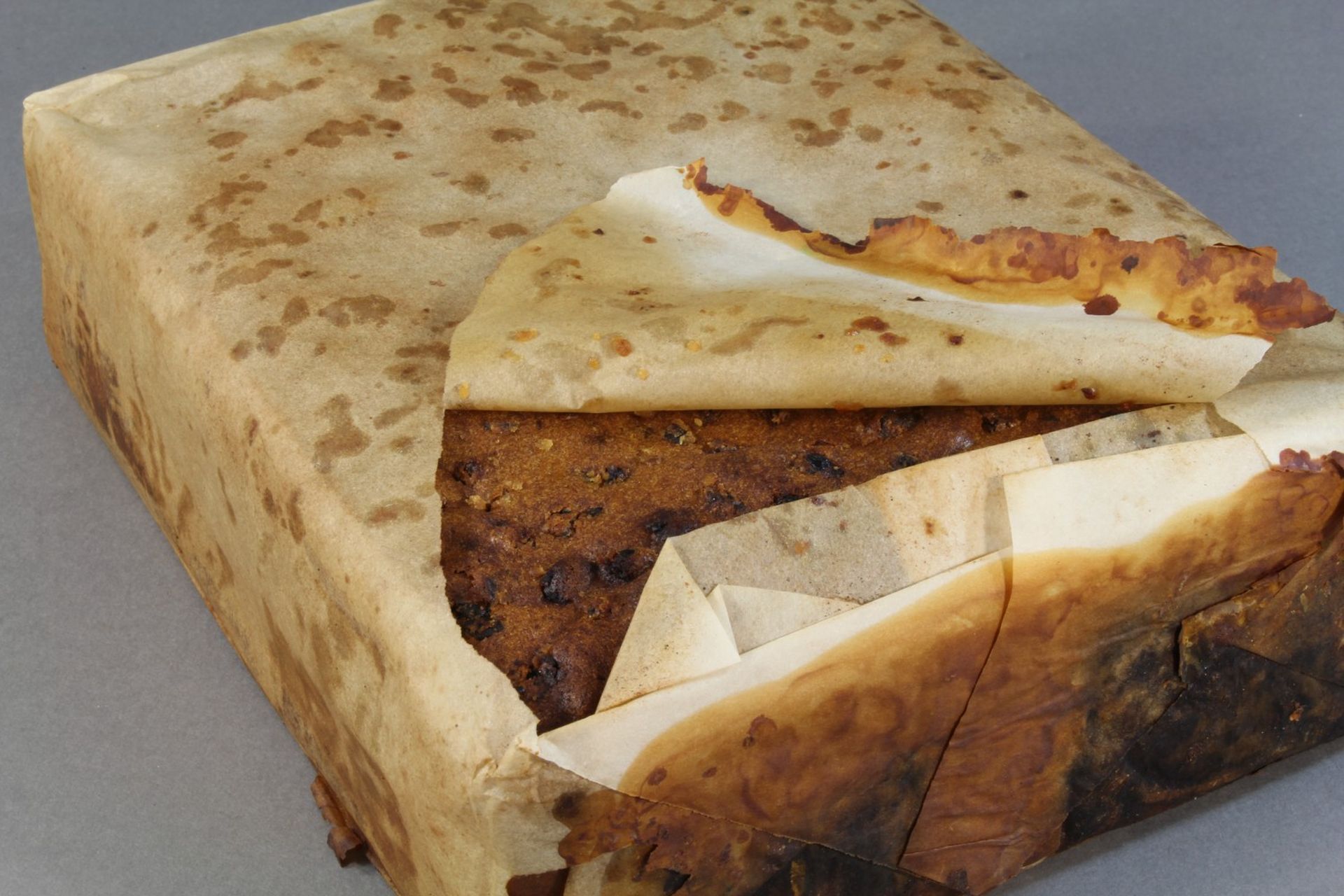 In 1957, John Tuck Jr. set out on a treacherous expedition that resulted in the third successful journey to the South Pole by foot and the first American outpost there. Along the way, Tuck discovered an abandoned cache that had been established by Robert Falcon Scott, one of the first to attempt this same adventure in 1911. Hidden inside rested an exceptionally well-preserved jar of Heinz horseradish that had been sitting, forgotten, for almost 45 years. Tuck tucked it away and eventually donated the bottle to Dartmouth College upon his return to the United States, where it is currently cared for as part of the College’s Hood Museum of Art. Given the genesis of this digital exhibition at Dartmouth, it seemed fitting to feature an object, albeit a more modern one, from the College’s own collection with ties to food, science, and the very early modern problem of surviving long-distance exploratory voyages.
In 1957, John Tuck Jr. set out on a treacherous expedition that resulted in the third successful journey to the South Pole by foot and the first American outpost there. Along the way, Tuck discovered an abandoned cache that had been established by Robert Falcon Scott, one of the first to attempt this same adventure in 1911. Hidden inside rested an exceptionally well-preserved jar of Heinz horseradish that had been sitting, forgotten, for almost 45 years. Tuck tucked it away and eventually donated the bottle to Dartmouth College upon his return to the United States, where it is currently cared for as part of the College’s Hood Museum of Art. Given the genesis of this digital exhibition at Dartmouth, it seemed fitting to feature an object, albeit a more modern one, from the College’s own collection with ties to food, science, and the very early modern problem of surviving long-distance exploratory voyages.
The cache Tuck uncovered was just one piece in a series of reserves that Scott and his crew had stationed to support their trek to and from Antarctica’s icy pole. The British team incorporated horseradish into these rations to stave off scurvy. Horseradish boasts both high vitamin C content and remarkable stability, and its inclusion harkens back to early modern practices of using food to battle scurvy as explored in this exhibition’s feature on portable soup. Unfortunately, the precaution was not entirely successful, as several members of Scott’s support team developed the deficiency during the infamous Terra Nova Expedition.
On November 1, 1911, Scott and four companions set off from Cape Evans, Antarctica as one of two crews locked in a race to be the first to set foot at the South Pole. The second was a Norwegian team headed by Roald Amundsen. After a grueling journey and several critical setbacks, Scott finally reached his destination only to find, to his devastation, an abandoned tent nearby—an undeniable sign that Amundsen and his men had arrived there first. (It turns out that Scott and his men reached the pole just 35 days after their competitors.) On their ill-fated return, Scott and his two surviving companions suffered a series of misfortunes before slowly starving to death in the midst of a blizzard a mere 11 miles from their base camp.
Roughly a year later, a search party stumbled upon the remains of the expedition’s tent, partially buried underneath a thick layer of ice. Inside, they discovered geological samples that Scott had instructed his men to gather during the final days of their journey, and which would later support the theory of continental drift, along with specimens of emperor penguin eggs.
It appears that one of the decisive factors behind the success of Amundsen’s expedition and the failure of Scott’s was their approach to food and nutrition. Even before the expedition began, Amundsen required his men to eat raw or nearly raw seal, a food notoriously rich in vitamins, but Scott refused to consume uncooked meat or put the same emphasis on pre-loading nutrients. Modern scholars estimate that because of the extreme cold, stress, and physical exertion required to make the journey, each man on the expedition likely required at least 5,500 calories per day. Amundsen’s men had rationed 4,560 calories, while the English team had apportioned 4,430; neither group had understood the extent of the physical demands that their journey would entail. Moreover, near the start of their journey, Amundsen cut three men from his team, leaving five men to use the resources provided for eight, whereas Scott, around the same time, added a fifth man to his crew but kept the caches stocked for four—personnel changes that further exacerbated the initial caloric differences between the two teams.

The bottle of ground horseradish was not the only food item from Scott’s expedition that an extreme polar climate pristinely preserved. The specter of climate change, however, throws into question whether such curiosities will continue to be archived by snow and ice. As reported in 2017, conservators found a Huntley & Palmers fruitcake that likely dates to the expedition, miraculously kept intact within a corroded tin can. The fruitcake was so well preserved that during initial conservation efforts, several members of the team commented on the century-old cake’s apparently still edible nature, exhibiting incredible pull as a food object even after so many decades left exposed to the elements. Lizzie Meeks, the Antarctic Heritage Trust’s program manager for artifacts, said, “There was a very, very slight rancid butter smell to it, but other than that, the cake looked and smelled edible! There is no doubt the extreme cold in Antarctica has assisted its preservation.”
No word, yet, on whether curators at Dartmouth’s Hood Museum have felt similar temptations from Scott’s Heinz horseradish.
Image: Bottle of Horseradish, glass, horseradish, and paper, early 20th century. Object 988.34.26951. Courtesy of the Hood Museum of Art, Dartmouth College.
 This article was written by Lauren Dorsey. For more information about her work and her other contributions to The Kitchen in the Cabinet click here.
This article was written by Lauren Dorsey. For more information about her work and her other contributions to The Kitchen in the Cabinet click here.
References
Antarctic Heritage Trust. “Century-Old Fruitcake.” August 10, 2017. https://nzaht.org/century-old-fruitcake/.
Chaloner, Bill and Paul Kenrick. “Did Captain Scott’s Terra Nova Expedition Discover Fossil Nothofagus in Antarctica?” The Linnean 31, no. 2 (October 2015): 11–17.
Daley, Jason. “Untouched, Century-Old Fruitcake Found In Antarctica.” Smithsonian Magazine. https://www.smithsonianmag.com/smart-news/immaculate-century-old-fruitcake-found-antarctica-180964504/.
Guly, Henry. “The Death of Robert Falcon Scott (1869–1912) and Colleagues.” Journal of Medical Biography 20, no. 4 (November 1, 2012): 160–63.
Hood Museum of Art. “Bottle of Horseradish.” https://hoodmuseum.dartmouth.edu/objects/988.34.26951.
Houston, C. Stuart. Review of Polar Journeys: The Role of Food and Nutrition in Early Exploration, by Robert E. Feeney. Arctic 51, no. 4 (December 1998): 386–87.
Jones, Max. The Last Great Quest: Captain Scott’s Antarctic Sacrifice. Oxford: Oxford University Press, 2004.
Larson, Edward J. An Empire of Ice: Scott, Shackleton, and the Heroic Age of Antarctic Science. New Haven, CT: Yale University Press, 2011.
Scott, Robert Falcon. Journals: Captain Scott’s Last Expedition. Edited by Max Jones. Oxford: Oxford University Press, 2006.
Sullivan, Walter. “John Tuck Jr. Is Dead at 51; Helped Build Outpost at Pole.” The New York Times, August 18, 1984, sec. Obituaries. https://www.nytimes.com/1984/08/18/obituaries/john-tuck-jr-is-dead-at-51-helped-build-outpost-at-pole.html.
Wedelsbäck Bladh, K., and K. M. Olsson. “Introduction and Use of Horseradish (Armoracia rusticana) as Food and Medicine from Antiquity to the Present: Emphasis on the Nordic Countries.” Journal of Herbs, Spices & Medicinal Plants 17, no. 3 (July 1, 2011): 197–213.